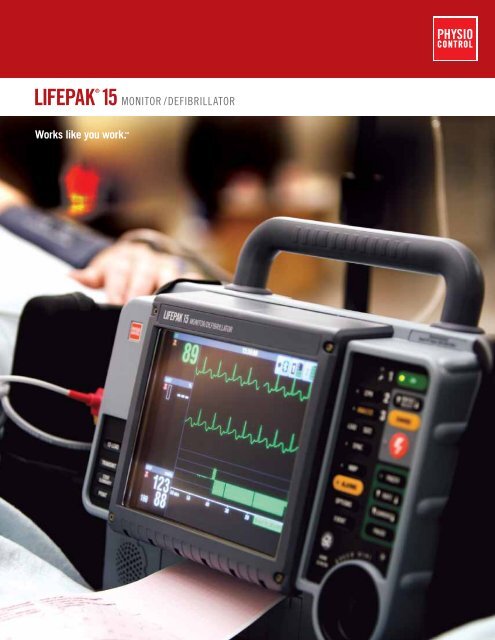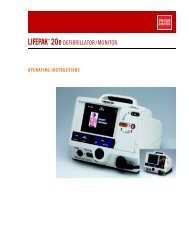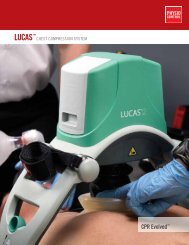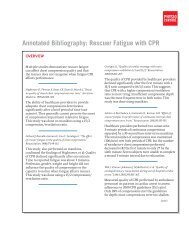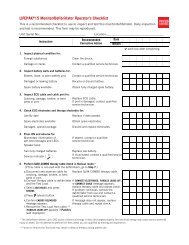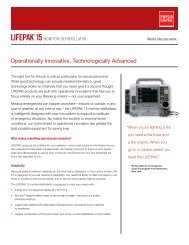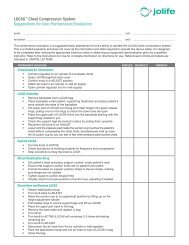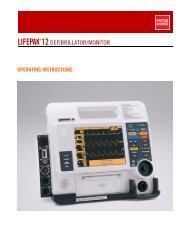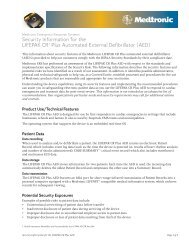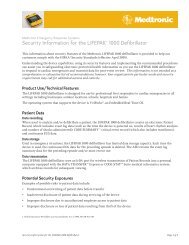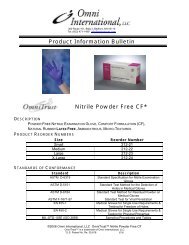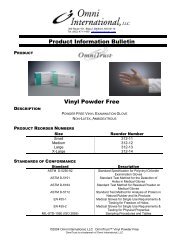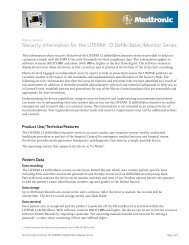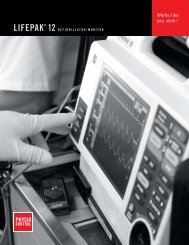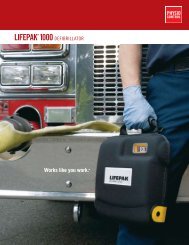LIFEPAK 15 MONITOR/DEfIbRIllaTOR - Trans Med USA
LIFEPAK 15 MONITOR/DEfIbRIllaTOR - Trans Med USA
LIFEPAK 15 MONITOR/DEfIbRIllaTOR - Trans Med USA
You also want an ePaper? Increase the reach of your titles
YUMPU automatically turns print PDFs into web optimized ePapers that Google loves.
®<br />
<strong>LIFEPAK</strong> <strong>15</strong> <strong>MONITOR</strong> /<strong>DEfIbRIllaTOR</strong><br />
Works like you work.
The New Standard<br />
for Advanced Care<br />
Your monitor is measured by what it can<br />
do for you. You need a product that has<br />
the latest clinical capabilities, is designed<br />
to provide the performance you need<br />
today and in the future, and is durable<br />
enough to ensure it continues to deliver<br />
in all the conditions you encounter when<br />
delivering patient care.<br />
Physio-Control defibrillators have set<br />
the standard for over 50 years, and the<br />
<strong>15</strong> raises the bar. We are leading the<br />
way with new clinical and operational<br />
innovations, and surrounded with<br />
legendary 360 degree durability that<br />
allows for maximum mobility.
Physio-Control supports you with the tools you need<br />
to improve patient care.<br />
Working WITH you<br />
Our five decades of working with hospitals gives us the depth of<br />
knowledge to offer innovative solutions that really work.<br />
Continuum of care<br />
From the streets to the emergency room to the administrative office,<br />
we offer a full suite of solutions, whether your need is code response or<br />
quality control analysis.<br />
Our product line ranges from AEDs for minimally trained responders<br />
(<strong>LIFEPAK</strong> CR Plus and <strong>LIFEPAK</strong> 1000 defibrillator) to sophisticated devices<br />
for ACLS (<strong>LIFEPAK</strong> 12 and <strong>LIFEPAK</strong> <strong>15</strong> monitor/defibrillators)<br />
to the ideal hospital crash-cart device (<strong>LIFEPAK</strong> 20e defibrillator/monitor).<br />
Consistency among our products means you can count on uniform<br />
energy doses across <strong>LIFEPAK</strong> devices, swap electrodes, easily share<br />
data, and minimize training costs. We also have the most widely-used<br />
button layout and user interface in the world, to keep things simple<br />
for you.<br />
Quality CPR to help save more lives<br />
Because effective CPR is so crucial in treating cardiac arrest,<br />
Physio-Control equips the new <strong>LIFEPAK</strong> <strong>15</strong> monitor/defibrillator with<br />
proven 4<br />
CPR guidance (the CPR Metronome) and offers the LUCAS<br />
Chest Compression System, designed to provide effective, consistent<br />
and uninterrupted compressions according to AHA Guidelines.<br />
In tandem with CODE-STAT data review software with Advanced<br />
CPR Analytics, these products give you a powerful feedback loop to<br />
drive improvements in resuscitation outcomes.<br />
Linking field and hospital to improve STEMI patient survival<br />
Studies show a significant association between prehospital 12-lead<br />
ECGs and shorter door-to-balloon times for patients with Acute<br />
Coronary Syndrome (ACS). Two recent studies found the effect was<br />
strongest when the cath lab was activated while the patient was still<br />
en route to the hospital. 5,6<br />
Minutes matter—if door-to-balloon time<br />
stretches from 90 minutes to 120 minutes, mortality for ACS has been<br />
shown to increase 40%. 7<br />
Receiving 12-lead ECGs from the field with the <strong>LIFEPAK</strong> 12 or<br />
<strong>LIFEPAK</strong> <strong>15</strong> monitor/defibrillator via the LIFENET Cardiac Care Network<br />
can help you meet the AHA/ACC 90-minute door-to-balloon guideline<br />
for patients with ST-segment elevation myocardial infarction (STEMI). 8<br />
While care teams focus on patients, the STEMI Management Solution<br />
from Physio-Control securely delivers ECG data when and where<br />
it’s needed, linking prehospital, emergency room, and percutaneous<br />
coronary intervention treatment teams.
Connecting patient data across your system<br />
Hospital quality and reporting standards are becoming increasingly<br />
stringent. Our data management solutions make it easy to transfer<br />
patient information from <strong>LIFEPAK</strong> devices to your PC, consolidate<br />
patient data, and analyze outcomes across your system.<br />
Use DT EXPRESS Data <strong>Trans</strong>fer Software to download critical event<br />
and waveform data from <strong>LIFEPAK</strong> devices to your PC, add supplemental<br />
patient data, print out a hardcopy report, and store records on a<br />
disk. Export data to CODE-STAT Data Review Software with Advanced<br />
CPR Analytics to consolidate all dispatch, treatment and outcome data<br />
into a single e-file.<br />
Training tools and implementation support<br />
to keep your staff up-to-date<br />
We build durable products and back them with a 5-year in-hospital<br />
warranty. We make them easy to configure for your patient care protocols<br />
and we provide software upgrades as technology advances.<br />
We realize it is time consuming and expensive to train your staff. To<br />
help you get the most out of your Physio-Control products, your sales<br />
representative will provide in-service training, and we also offer specialized<br />
instruction—ranging from self-paced CDs to live webcasts to<br />
on-site classes.<br />
We aim to be the “gold standard” in customer education. We are<br />
committed to providing you with high quality training and education on<br />
our <strong>LIFEPAK</strong> defibrillators. Our biomed training seminars will reinforce<br />
your skills and provide you with tools to make you comfortable with the<br />
device both inside and out.
<strong>LIFEPAK</strong> <strong>15</strong> Monitor/Defibrillator<br />
The New Standard for Advanced Care<br />
...in Clinical Innovation<br />
n The most potent escalating energy available—ADAPTIV biphasic technology provides the option<br />
to escalate to 360J for best results. Recent studies have shown that refibrillation is common among VF<br />
cardiac arrest patients and that defibrillation of recurring episodes of VF is increasingly difficult. 1,2,3<br />
One<br />
study “…clearly demonstrated higher rates of VF termination and conversion to an organized rhythm<br />
with the escalating higher-energy regimen when persistent or recurrent VF necessitated delivery of<br />
multiple shocks.” 1<br />
The <strong>15</strong> gives you the option to escalate your energy dosing up to 360J for difficult-todefibrillate<br />
patients.<br />
n Monitoring parameters to meet your needs—The <strong>LIFEPAK</strong> <strong>15</strong> monitor/defibrillator has the<br />
ability to monitor multiple parameters such as NIBP, SpO2, End-tidal CO2, and Invasive Pressures.<br />
At the same time, the <strong>15</strong> offers the ability to defibrillate and pace, simplifying the amount of<br />
equipment required.<br />
n New monitoring parameters—Detect hard-to-diagnose conditions and improve patient care with<br />
Masimo ®<br />
Rainbow ®<br />
Technology. The <strong>15</strong> is the first monitor integrating noninvasive monitoring for carbon<br />
monoxide and methemoglobin (to detect chemical exposures and certain drugs).<br />
n Advanced support for treating STEMI patients—Easily acquire a pre-medication 12-lead ECG and<br />
then rely on the <strong>15</strong> to continuously monitor all 12 leads in the background and alert you to changes via<br />
our ST-Segment Trending feature. Because ECGs (and STEMI diagnosis) can change so quickly, the <strong>15</strong><br />
takes ECGs at frequent intervals and alerts you to changes in a patient’s ST measurement. Using your<br />
<strong>15</strong> in conjunction with the Web-based LIFENET STEMI Management Solution allows you to automatically<br />
share data from pre-hospital to hospital and to activate care teams.<br />
n Proven CPR guidance—Demonstrated to aid users in performing compressions and ventilations<br />
within the recommended range of the AHA Guidelines, 4<br />
the CPR Metronome uses audible prompts to<br />
guide you without distracting vocal critique. And get the post-event feedback you need to improve CPR<br />
performance with CODE-STAT data review software with Advanced CPR Analytics.
...in Operational Innovation<br />
n Maximum viewability on transports and in a patient room—<br />
Large screen (8.4 inches diagonally), high resolution, and full-color<br />
display provide maximum viewability from all angles, making the <strong>15</strong><br />
ideal for in-hospital transport.<br />
n Latest Lithium-ion battery technology—Battery power that<br />
beats or matches every competitor in the market. And the smart<br />
technology included in this battery system helps you manage your<br />
battery inventory appropriately, letting you know when battery life is<br />
coming to an end.<br />
n Data management—As you treat patients, collect monitoring<br />
data in your <strong>LIFEPAK</strong> monitor/defibrillator. The <strong>15</strong> packs 16 times<br />
the memory and has 4 times more storage space for clinical data<br />
than the 12. Easily transmit data so information flows to where<br />
it’s needed. Whether you prefer the CODE SUMMARY printed<br />
record, or whether you want less paper, we have you covered.<br />
A variety of trending reports and event markers are available, to<br />
help you capture the data you need for patient records, clinical<br />
research, and quality assurance. And, the <strong>15</strong> is equipped with<br />
built-in Bluetooth ®<br />
technology.<br />
n Upgradeable platform—Our products are built as platforms—<br />
flexible to adapt to evolving protocols and new guidelines and<br />
upgradeable when you are ready to deliver new therapies. With<br />
10 times more processing power and speed than the 12, the <strong>15</strong> is<br />
designed to grow as your needs change, helping you avoid costly<br />
premature replacements. This flexibility means the <strong>15</strong> is ready for<br />
the anticipated changes coming from the 2010 Guidelines.<br />
n Attention to detail—We didn’t overlook a thing. Finishing touches<br />
on this next-generation monitor/defibrillator include an ergonomic<br />
handle, large speed-dial wheel for easy selection, and updated,<br />
easy-to-clean keypad.<br />
...with Maximum Mobility<br />
n Works when dropped or kicked during transport—The<br />
<strong>LIFEPAK</strong> <strong>15</strong> device is the only device rated to withstand a 30”<br />
fall from bed height or a drop in transit. The double-layer screen<br />
can withstand crashes in elevators and hallways. Reinforced and<br />
redesigned cable connections lock tight for confident monitoring<br />
and therapy delivery. Easy to clean—industry-leading IP44 rating<br />
protects from fluids and substances, and exterior case and<br />
keypads are designed to help you meet requirements.<br />
n Always ready—The unit’s self-checking feature alerts the service<br />
team if the device needs attention—so you know it’s ready when<br />
you need it. An atomic clock in the device keeps you on time.
<strong>LIFEPAK</strong> <strong>15</strong> Monitor/Defibrillator<br />
The New Standard for Advanced Care<br />
1<br />
2<br />
3<br />
4<br />
5<br />
6<br />
7<br />
The only monitor/defibrillator on the market<br />
with Carbon Monoxide and Methemoglobin<br />
monitoring integrated into the device.<br />
ST-Trending and 12-lead ECG transmissions<br />
via the LIFENET STEMI Management Solution<br />
makes the <strong>15</strong> a vital part of reducing door-toballoon<br />
times.<br />
CPR Metronome is a proven technology<br />
that actively guides users to a consistent<br />
compression rate without the need for extra<br />
external hardware. 4<br />
Latest Lithium-ion battery technology allows for<br />
nearly six hours of run time and an approximate<br />
two-year replacement cycle.<br />
Redesigned cable connector gives you<br />
confidence for secure therapy delivery.<br />
Ergonomically designed handle has built-in<br />
shock absorbers for cushion.<br />
Large screen, high resolution, and full-color<br />
display provide maximum viewability from<br />
all angles.
With nearly 100,000 <strong>LIFEPAK</strong> 12 devices in use worldwide, we had an incredible natural<br />
laboratory to work with in designing the <strong>LIFEPAK</strong> <strong>15</strong> monitor/defibrillator.
Building on a Proud Legacy<br />
The pioneer in portable defibrillation and monitoring technology, Physio-Control continues to define the<br />
standard for cardiac care equipment.<br />
Our <strong>LIFEPAK</strong> devices have been carried to the top of Mount Everest and launched into orbit on the<br />
International Space Station. More than half a million units are in use today on hospital crash carts, in<br />
cardiac catheterization labs, fire rescue rigs and ambulances worldwide. Since Physio-Control was<br />
founded in 1955, our products have helped save tens of thousands of lives and positively impacted<br />
countless more.<br />
Even as we bring ground-breaking products to market, some things don’t change. As always, the<br />
<strong>LIFEPAK</strong> name stands for a dependable, portable device that you can trust—every single day.<br />
A <strong>LIFEPAK</strong> device never stands on its own. Our goal is to provide complete solutions for cardiac<br />
emergencies—from first responder through the hospital. Our products are systems. Everything works<br />
with you – whether it’s accessories, disposables, flexible energy dosing, or data solutions that help you<br />
capture patient data and learn from it to improve care.<br />
When you buy a <strong>LIFEPAK</strong> monitor/defibrillator, you get a leading-edge monitor/defibrillator and the<br />
company that stands behind it:<br />
• Innovators continually at the forefront of improving patient care—ADAPTIV biphasic technology<br />
up to 360J to give patients the best chance at survival; secure, web-based flow of ECG data to help<br />
improve STEMI patient outcomes; the first defibrillator designed specifically for the hospital market;<br />
carbon monoxide monitoring to catch the number-one cause of poisoning deaths; and methemoglobin<br />
monitoring to detect chemical exposures and certain drugs.<br />
• The pioneers of prehospital cardiac monitoring and defibrillating equipment.<br />
• Industry-leading technical field service.<br />
• A company that has been in business for more than five decades.<br />
We’re inspired and informed by the clinicians who use our products in life-threatening situations every<br />
day. Knowledge gained from working with some of the world’s largest hospitals keeps us innovating—<br />
raising the bar on durability and clinical standards.
Physio-Control Products and Solutions<br />
Experience the legendary quality that has made <strong>LIFEPAK</strong> products<br />
and services the clear favorite around the world.<br />
Physio-Control provides complete patient care monitoring and defibrillation solutions to reduce total cost of ownership and<br />
ensure compatibility with earlier systems whenever possible. Integrated solutions provide the right service options, disposables,<br />
cables, accessories and data offerings.<br />
<strong>LIFEPAK</strong> ®<br />
Defibrillator/Monitors<br />
<strong>LIFEPAK</strong> 20e Defibrillator/Monitor<br />
Building on the design of its predecessor, the <strong>LIFEPAK</strong> 20e<br />
defibrillator/monitor is compact, lightweight and easy to rush to the<br />
scene or use during transport. The 20e is highly intuitive to use,<br />
putting early, effective defibrillation into the hands of first responders.<br />
The 20e skillfully combines AED function with manual capability so<br />
that ACLS-trained clinicians can quickly and easily deliver advanced<br />
diagnostic and therapeutic care. Clinically advanced and packed<br />
with power, the 20e uses lithium-ion battery technology that provides<br />
extended monitoring time for transporting patients from one area of<br />
the hospital to another and includes ADAPTIV biphasic technology<br />
up to 360J.<br />
<strong>LIFEPAK</strong> 1000 Defibrillator<br />
Providing a powerful yet compact way to treat cardiac arrest patients,<br />
its intuitive, simple operation is ideal for first responders, and includes<br />
built-in flexibility for more advanced patient care. The 1000 is designed for<br />
external areas of the hospital where a simple-to-use AED with the option<br />
of manual defibrillation is required.<br />
<strong>LIFEPAK</strong> CR ®<br />
Plus Automated External Defibrillator<br />
Designed for use by the first person at the scene of a sudden cardiac<br />
arrest. Ideal for the minimally trained rescuer, the CR Plus guides the<br />
rescuer step-by-step with calm, clear voice prompts. The simplicity of the<br />
CR Plus means it’s ideal for non-acute hospital areas.
CPR Assistance<br />
LUCAS Chest Compression System<br />
Designed to provide effective, consistent and uninterrupted compressions<br />
according to AHA/ERC Guidelines, the device is used on patients<br />
in hospital and out-of-hospital settings. LUCAS is translucent, except for<br />
the hood and piston, making it the ideal chest compression device for<br />
use in the cath lab. Maintaining high-quality, hands-free compressions<br />
frees responders to focus on other lifesaving therapies.<br />
LIFENET ®<br />
System<br />
LIFENET STEMI Management Solution<br />
Enabling a seamless, secure and flexible flow of ECG data among<br />
prehospital to hospital helps you quickly identify STEMI patients,<br />
improve door-to-balloon times and reduce false-positive cath lab<br />
activations. A complete Web-based STEMI management solution, our<br />
system requires no dedicated equipment, servers or maintenance from<br />
your IT department.<br />
CODE-STAT Data Review Software<br />
with Advanced CPR Analytics<br />
This post-event review tool annotates chest compressions onto the<br />
patient’s continuous ECG report and calculates CPR statistics to help<br />
you meet current AHA/ERC Guidelines. The software simplifies data<br />
collection and reporting by consolidating all dispatch, treatment and<br />
outcome data into a single e-file. Download, review, manage, and<br />
analyze emergency medical data from multiple <strong>LIFEPAK</strong> defibrillators.<br />
The application also facilitates quality analysis and business decisions,<br />
allowing creation of benchmarking and trending reports to review your<br />
system’s performance.<br />
DT EXPRESS Data <strong>Trans</strong>fer Software<br />
Consolidate data from your sudden cardiac arrests and emergency<br />
transports into your hospital information systems. The simple Windows ®<br />
-<br />
based software application manages data from <strong>LIFEPAK</strong> defibrillator/<br />
monitors. The software makes it easy to download critical event and<br />
waveform data to your PC, add supplemental patient data, print a<br />
hardcopy report, and store records on a disk. For storage and onscreen<br />
viewing of reports, export files to CODE-STAT data<br />
review software.
Specifications<br />
GENERAL<br />
The <strong>LIFEPAK</strong> <strong>15</strong> monitor/defibrillator has six main<br />
operating modes:<br />
AED mode: for automated ECG analysis and a prompted treatment<br />
protocol for patients in cardiac arrest.<br />
Manual mode: for performing manual defibrillation, synchronized<br />
cardioversion, noninvasive pacing, and ECG and vital sign monitoring.<br />
Archive mode: for accessing stored patient information.<br />
Setup mode: for changing default settings of the operating functions.<br />
Service mode: for authorized personnel to perform diagnostic<br />
tests and calibrations.<br />
Demo mode: for simulated waveforms and trend graphs for<br />
demonstration purposes.<br />
PHYSICAL CHARACTERISTICS<br />
Weight:<br />
Basic monitor/defibrillator with new roll paper and two batteries<br />
installed 8.6 kg (18.9 lb);<br />
Fully featured monitor/defibrillator with new roll paper and two<br />
batteries installed: 9.1 kg (20.1 lb)<br />
Lithium-ion battery: 0.59 kg (1.3 lb)<br />
Accessory bags and shoulder strap: 1.77 kg (3.9 lb)<br />
Standard (hard) paddles: 0.95 kg (2.1 lb)<br />
Height: 31.7 cm (12.5 in)<br />
Width: 40.1 cm (<strong>15</strong>.8 in)<br />
Depth: 23.1 cm (9.1 in)<br />
DISPLAY<br />
Size (active viewing area): 212 mm (8.4 in) diagonal; 171 mm<br />
(6.7 in) wide x 128 mm (5.0 in) high<br />
Resolution:<br />
Display Type 640 dot x 480 dot color backlit LCD<br />
User selectable display mode: full color or SunVue<br />
high contrast<br />
Display: a minimum of 4 seconds of ECG and alphanumerics for<br />
values, device instructions, or prompts<br />
Display: up to three waveforms<br />
Waveform display sweep speed: 25 mm/sec for ECG, SpO2, IP,<br />
and 12.5 mm/sec for CO2 DATA MANAGEMENT<br />
The device captures and stores patient data, events (including<br />
waveforms and annotations), and continuous waveform and<br />
patient impedance records in internal memory.<br />
The user can select and print reports, and transfer the stored<br />
information via supported communication methods.<br />
Report Types:<br />
• Three format types of CODE SUMMARY critical event record<br />
(short, medium, and long):<br />
• 12-lead ECG with STEMI statements<br />
• Continuous ECG (transfer only)<br />
• Trend Summary<br />
• Vital Sign Summary<br />
• Snapshot<br />
Memory Capacity: Total capacity is 360 minutes of continuous<br />
ECG and 400 single waveform events.<br />
Maximum memory capacity for a single patient includes up to 200<br />
single waveform reports and 90 minutes of continuous ECG.<br />
COMMUNICATIONS<br />
The device is capable of transferring data records by wired or<br />
wireless connection.<br />
Serial Port RS232 communication + 12V available<br />
Limited to devices drawing maximum 0.5 A current<br />
Bluetooth ®<br />
technology provides short-range wireless<br />
communication with other Bluetooth-enabled devices.<br />
<strong>MONITOR</strong><br />
ECG<br />
ECG is monitored via several cable arrangements:<br />
A 3-wire cable is used for 3-lead ECG monitoring.<br />
A 5-wire cable is used for 7-lead ECG monitoring.<br />
A 10-wire cable is used for 12-lead ECG acquisition. When the<br />
chest electrodes are removed, the 10-wire cable functions as a<br />
4-wire cable.<br />
Standard paddles or QUIK-COMBO pacing/defibrillation/ECG<br />
electrodes are used for paddles lead monitoring.<br />
Frequency Response:<br />
Monitor: 0.5 to 40 Hz or 1 to 30 Hz<br />
Paddles: 2.5 to 30 Hz<br />
Lead Selection:<br />
Leads I, II, III (3-wire ECG cable)<br />
Leads I, II, III, AVR, AVL, and AVF acquired simultaneously<br />
(4-wire ECG cable)<br />
Leads I, II, III, AVR, AVL, AVF, and C lead acquired simultaneously<br />
(5-wire ECG cable)<br />
Leads I, II, III, AVR, AVL, AVF, V1, V2, V3, V4, V5, and V6 acquired<br />
simultaneously (10-wire ECG cable)<br />
ECG Size: 4, 3, 2.5, 2, 1.5, 1, 0.5, 0.25 cm/mV (fixed at 1 cm/mV<br />
for 12-lead)<br />
Heart Rate Display:<br />
20–300 bpm digital display<br />
Accuracy: ±4% or ±3 bpm, whichever is greater<br />
QRS Detection Range Duration: 40 to 120 msec<br />
Amplitude: 0.5 to 5.0 mV<br />
Heart Symbol: flashes for each QRS detection<br />
Common Mode Rejection (CMRR): ECG Leads: 90 dB at<br />
50/60 Hz<br />
SpO 2<br />
Sensors: MASIMO ®<br />
Sensors including Rainbow Sensors<br />
Displayed Saturation Range: 50 to 100%<br />
Saturation Accuracy: 70–100% (0–69% unspecified)<br />
Adults/Pediatrics:<br />
±2 digits (during no motion conditions)<br />
±3 digits (during motion conditions)<br />
Dynamic signal strength bar graph<br />
Pulse tone as SpO2 pulsations are detected<br />
SpO2 Update Averaging Rate User selectable: 4, 8, 12 or<br />
16 seconds<br />
SpO2 Sensitivity User selectable: Normal, High<br />
SpO2 Measurement: Functional SpO2 values are displayed<br />
and stored<br />
Pulse Rate Range: 25 to 240 bpm<br />
Pulse Rate Accuracy (Adults/Pediatrics):<br />
±3 digits (during no motion conditions)<br />
±5 digits (during motion conditions)<br />
Optional SpO2 waveform display with autogain control<br />
SpCO <br />
Sensor: Only Rainbow Sensors<br />
SpCO Concentration Display Range: 0 to 40%<br />
SpCO Accuracy: ±3 digits<br />
SpMet <br />
Sensor: Only Rainbow Sensors<br />
SpMet Saturation Range: 0 to <strong>15</strong>.0%<br />
SpMet Display Resolution: 0.1% up to 10%, then single digit<br />
resolution up to <strong>15</strong>%<br />
SpMet Accuracy: ±1 digit<br />
NIBP<br />
Blood Pressure Systolic Pressure Range: 30 to 255 mmHg<br />
Diastolic Pressure Range: <strong>15</strong> to 220 mmHg<br />
Mean Arterial Pressure Range: 20 to 235 mmHg<br />
Units: mmHg<br />
Blood Pressure Accuracy: ±5 mmHg<br />
Blood Pressure Measurement Time: 20 seconds, typical<br />
(excluding cuff inflation time)<br />
Pulse Rate Range: 30 to 240 pulses per minute<br />
Pulse Rate Accuracy: ±2 pulses per minute or ±2%, whichever<br />
is greater<br />
Operation Features Initial Cuff Pressure: User selectable, 80 to<br />
180 mmHg<br />
Automatic Measurement Time Interval: User selectable from<br />
2 min to 60 min<br />
Automatic Cuff Deflation Excessive Pressure: If cuff pressure<br />
exceeds 290 mmHg<br />
Excessive Time: If measurement time exceeds 120 seconds<br />
CO 2<br />
CO2 Range: 0 to 99 mmHg<br />
Units: mmHg, %, kPA<br />
Respiration Rate Accuracy:<br />
0 to 70 bpm: ±1 bpm<br />
71 to 99 bpm: ±2 bpm<br />
Respiration Rate Range: 0 to 99 breaths/minute<br />
Rise Time: 190 msec<br />
Response Time: 3.3 seconds (includes delay time and rise time)<br />
Initialization Time: 30 seconds (typical), 10-180 seconds<br />
Ambient Pressure: automatically compensated internally<br />
Optional Display: CO2 pressure waveform<br />
Scale factors: Autoscale, 0–20 mmHg (0–4 Vol%),0–50 mmHg<br />
(0–7 Vol%), 0–100 mmHg (0–14 Vol%)<br />
Invasive Pressure<br />
<strong>Trans</strong>ducer Type: Strain-gauge resistive bridge<br />
<strong>Trans</strong>ducer Sensitivity: 5µV/V/mmHg<br />
Excitation Voltage: 5 VDC<br />
Connector: Electro Shield: CXS 3102A 14S-6S<br />
Bandwidth: Digital filtered, DC to 30 Hz (< -3db)<br />
Zero Drift: 1 mmHg/hr without transducer drift<br />
Zero Adjustment: ±<strong>15</strong>0 mmHg including transducer offset<br />
Numeric Accuracy: ±1 mmHg or 2% of reading, whichever is<br />
greater, plus transducer error<br />
Pressure Range: -30 to 300 mmHg, in six user<br />
selectable ranges
Invasive Pressure Display<br />
Display: IP waveform and numerics<br />
Units: mmHg<br />
Labels: P1 or P2, ART, PA, CVP, ICP, LAP (user selectable)<br />
Trend<br />
Time Scale: Auto, 30 minutes, 1, 2, 4, or 8 hours<br />
Duration: Up to 8 hours<br />
ST Segment: After initial 12-lead ECG analysis, automatically<br />
selects and trends ECG lead with the greatest ST displacement<br />
Display Choice of: HR, PR (SpO2), PR (NIBP), SpO2,(%), SpCO,(%),<br />
SpMet,(%), CO2 (EtCO2/FiCO2), RR (CO2), NIBP, IP1, IP2, ST<br />
ALARMS<br />
Quick Set: Activates alarms for all active vital signs and includes<br />
an indicator for which alarms are active.<br />
VF/VT Alarm: Activates continuous Continuous Patient Surveillance<br />
System (CPSS) monitoring in Manual mode<br />
Apnea Alarm: Occurs when 30 seconds has elapsed since last<br />
detected respiration<br />
Heart Rate Alarm Limit Range: Upper, 100–250 bpm; lower,<br />
30–<strong>15</strong>0 bpm<br />
INTERPRETIVE ALGORITHM<br />
12-Lead Interpretive Algorithm: University of Glasgow 12-Lead<br />
ECG Analysis Program, includes AMI and STEMI statements<br />
PRINTER<br />
Prints continuous strip of the displayed patient information<br />
and reports<br />
Paper Size: 100 mm (3.9 in)<br />
Print Speed: 25 mm/sec or 12.5 mm/sec<br />
Optional: 50 mm/sec time base for 12-lead ECG reports<br />
Delay: 8 seconds<br />
Autoprint: Waveform events print automatically (user selectable)<br />
Frequency Response:<br />
Diagnostic: 0.05 to <strong>15</strong>0 Hz or 0.05 to 40 Hz<br />
Monitor: 0.5 to 40 Hz or 1 to 30 Hz<br />
DEFIBRILLATOR<br />
Biphasic Waveform: Biphasic Truncated Exponential<br />
The following specifications apply from 25 to 200 ohms,<br />
unless otherwise specified:<br />
Energy Accuracy: ±1 joule or 10% of setting, whichever is<br />
greater, into 50 ohms ±2 joules or <strong>15</strong>% of setting, whichever is<br />
greater, into 25-175 ohms.<br />
Voltage Compensation: Active when disposable therapy<br />
electrodes are attached. Energy output within ±5% or ±1 joule,<br />
whichever is greater, of 50 ohms value, limited to the available<br />
energy which results in the delivery of 360 joules into 50 ohms.<br />
Paddle Options: QUIK-COMBO ®<br />
pacing/defibrillation/ECG<br />
electrodes (standard). Cable Length 8 foot long (2.4 m)<br />
QUIK-COMBO cable (not including electrode assembly)<br />
Standard paddles (optional)<br />
Manual Mode<br />
Energy Select: 2, 3, 4, 5, 6, 7, 8, 9, 10, <strong>15</strong>, 20, 30, 50, 70, 100,<br />
125, <strong>15</strong>0, 175, 200, 225, 250, 275, 300, 325, and 360 joules<br />
Charge Time: Charge time to 360 joules in less than<br />
10 seconds, typical<br />
Synchronous cardioversion: Energy transfer begins within 60<br />
msec of the QRS peak<br />
Paddles Lead Off Sensing: The transition point at which device<br />
changes from assuming that QUIK-COMBO electrodes are<br />
properly connected to patient to assuming that electrodes are not<br />
connected is 300±50 ohms.<br />
AED Mode<br />
Shock Advisory System (SAS): an ECG analysis system<br />
that advises the operator if the algorithm detects a shockable or nonshockable<br />
ECG rhythm. SAS acquires ECG via therapy electrodes only.<br />
Shock Ready Time: Using a fully charged battery at normal room<br />
temperature, the device is ready to shock within 20 seconds if the<br />
initial rhythm finding is “SHOCK ADVISED”<br />
Biphasic Output: Energy Shock levels ranging from<br />
<strong>15</strong>0–360 joules with same or greater energy level for each<br />
successive shock<br />
cprMAX Technology: In AED mode, cprMAX technology<br />
provides a method of maximizing the CPR time that a patient<br />
receives, with the overall goal of improving the rate of survival of<br />
patients treated with AEDs.<br />
Setup Options:<br />
• Auto Analyze: Allows for auto analysis. Options are OFF,<br />
AFTER 1ST SHOCK<br />
• Initial CPR: Allows the user to be prompted for CPR for a period<br />
of time prior to other activity. Options are OFF, ANALYZE FIRST,<br />
CPR FIRST<br />
• Initial CPR Time: Time interval for Initial CPR. Options are <strong>15</strong>, 30,<br />
45, 60, 90, 120, and 180 seconds.<br />
• Pre-Shock CPR: Allows the user to be prompted for CPR while<br />
the device is charging. Options are OFF, <strong>15</strong>, 30 seconds.<br />
• Pulse Check: Allows the user to be prompted for a pulse check<br />
at various time. Options are ALWAYS, AFTER EVERY SECOND<br />
NSA, AFTER EVERY NSA, NEVER<br />
• Stacked Shocks: Allows for CPR after 3 consecutive shocks or<br />
after a single shock. Options are OFF, ON<br />
• CPR Time: 1 or 2 User selectable times for CPR. Options are <strong>15</strong>,<br />
30, 45, 60, 90, 120, 180 seconds and 30 minutes.<br />
PACER<br />
Pacing Mode: Demand or non-demand rate and current defaults<br />
(user configurable)<br />
Pacing Rate: 40 to 170 PPM<br />
Rate Accuracy: ±1.5% over entire range<br />
Output Waveform: Monophasic, truncated exponential current<br />
pulse (20 +1.5 msec)<br />
Output Current: 0 to 200 mA<br />
Pause: Pacing pulse frequency reduced by a factor of 4 when activated<br />
Refractory Period: 200 to 300 msec ±3% (function of rate)<br />
ENVIRONMENTAL<br />
Unit meets functional requirements during exposure to the<br />
following environments unless otherwise stated.<br />
Operating Temperature: 0° to 45°C (32° to 113°F); -20°C (-4°F)<br />
for 1 hour after storage at room temperature; 60°C (140°F) for 1<br />
hour after storage at room temperature<br />
Storage Temperature: -20° to 65°C (-4° to 149°F) except therapy<br />
electrodes and batteries<br />
Relative Humidity, Operating: 5 to 95%, non-condensing.<br />
NIBP only: <strong>15</strong> to 95%, non-condensing<br />
Atmospheric Pressure, Operating: -382 to 4,572 m (-1,253 to<br />
<strong>15</strong>,000 ft). NIBP only: -<strong>15</strong>2 to 3,048 m (-500 to 10,000 ft)<br />
Water Resistance, Operating: IP44 (splash proof, dust and sand<br />
resistant) per IEC 529 and EN 1789 (without accessories except for<br />
12-lead ECG cable, hard paddles, and battery pack)<br />
Vibration: MIL-STD-810E Method 514.4, Propeller Aircraft -<br />
category 4 (figure 514.4-7 spectrum a), Helicopter - category 6<br />
(3.75 Grms), Ground Mobile - category 8 (3.14 Grms), EN 1789:<br />
Sinusoidal Sweep, 1 octave/min, 10-<strong>15</strong>0 Hz, ±0.<strong>15</strong> mm/2 g<br />
Shock (drop): 5 drops on each side from 18 inches onto a steel<br />
surface EN 1789: 30-inch drop onto each of 6 surfaces<br />
Shock (functional): Meets IEC 60068-2-27 and MIL-STD-810E<br />
shock requirements 3 shocks per face at 40 g, 6 ms half-sine pulses<br />
Bump: 1000 bumps at <strong>15</strong> g with pulse duration of 6 msec<br />
Impact, Non-operating: IEC 60601-1 0.5 + 0.05 joule impact UL<br />
60601-1 6.78 Nm impact with 2-inch diameter steel ball. Meets<br />
IEC62262 protection level IK 04.<br />
EMC: EN 60601-1-2:2001 <strong>Med</strong>ical Equipment - General<br />
Requirements for Safety - Collateral Standard: Electromagnetic<br />
Compatibility - Requirements and Tests EN 60601-2-4:2003:<br />
(Clause 36) Particular Requirements for the Safety of Cardiac<br />
Defibrillators and Cardiac Defibrillator-Monitors<br />
Cleaning: Cleaning 20 times with the following: Quaternary<br />
ammonium, isopropyl alcohol, hydrogen peroxide<br />
Chemical Resistance: 60 hour exposure to specified chemicals:<br />
Betadine (10% Povidone-Iodine solution), Coffee, Cola, Dextroxe (5%<br />
Glucose solution), Electrode Gel/Paste (98% water, 2% Carbopol<br />
940), HCL (0.5% solution, pH=1), Isopropyl Alcohol, NaCl solution<br />
(0.9% solution), Cosmetic discoloration of the paddle well shorting<br />
bar shall be allowed following exposure to HCL (0.5% solution).<br />
POWER<br />
Dual battery: Capability with automatic switching<br />
Low battery indication and message: Low battery fuel gauge<br />
indication and low battery message in status area for each battery<br />
Replace battery indication and message: Replace battery fuel<br />
gauge indication, audio tones and replace battery message in the<br />
status area for each battery. When replace battery is indicated, device<br />
auto-switches to second battery. When both batteries reach replace<br />
battery condition, a voice prompt instructs user to replace battery.<br />
Battery Capacity For two, new fully-charged batteries, 20°C (68°F)<br />
Operating Mode<br />
Monitoring Pacing Defibrillation<br />
(minutes) (minutes) (360J discharges)<br />
Total Capacity<br />
to Shutdown<br />
Capacity After<br />
Low Battery<br />
BATTERY<br />
Typical 360 340 420<br />
Minimum 340 320 400<br />
Typical 21 20 30<br />
Minimum 12 10 6<br />
Battery Specifications<br />
Battery Type: Lithium-ion<br />
Weight: 0.59 kg (1.3 lb)<br />
Voltage: 11.1V typical<br />
Capacity (rated): 5.7 amp hours<br />
Charge Time (with fully depleted battery): 4.5 hours (typical)<br />
Battery indicators: Each battery has a fuel gauge that<br />
indicates its approximate charge. A fuel gauge that shows<br />
two or fewer LEDs after a charge cycle indicates that the<br />
battery should be replaced.<br />
Charging Temperature Range: 5° to 35°C (41° to 95°F)<br />
Operating Temperature Range: 0° to 50°C (32° to 122°F)<br />
Long Term (>1 day) Storage Temperature Range: 0° to 35°C<br />
(32° to 95°F)
For more than 50 years, Physio-Control, maker of the renowned<br />
<strong>LIFEPAK</strong> defibrillators, has been developing technologies and designing<br />
devices that are legendary among first response professionals, clinical<br />
care providers and the community.<br />
REFERENCES<br />
1. Stiell IG, Walker RG, Nesbitt LP, et al. Biphasic Trial: A randomized comparison of fixed lower versus escalating higher energy levels<br />
for defibrillation in out-of-hospital cardiac arrest. Circulation. 2007;1<strong>15</strong>:<strong>15</strong>11-<strong>15</strong>17.<br />
2. Koster RW, et al. Recurrent ventricular fibrillation during advanced life support care of patients with prehospital cardiac arrest.<br />
Resuscitation. 2008;78:252-257.<br />
3. Walsh SJ, et al. Efficacy of distinct energy delivery protocols comparing two biphasic defibrillators for cardiac arrest. AM J Cardiol.<br />
2004;94:378-380.<br />
4. Kern KB, et al. A compression/ventilation metronome prevents hyperventilation by professional rescuers. Circulation. 2008; 118:S_766<br />
(abstract).<br />
5. Swor R, et al. Prehospital 12-lead ECG: efficacy or effectiveness? Prehosp Emerg Care. 2006;10:374-377<br />
6. Bradley EH, et al. Strategies for reducing the door-to-balloon time in acute myocardial infarction. N Engl J <strong>Med</strong>. 2006;355:2308-2320.<br />
7. McNamara RL, et al. Effect of door-to-balloon time on mortality in patients with ST-segment elevation myocardial infarction. J Am Coll<br />
Cardiol. 2006;47:2180-2186.<br />
8. Antman EM, et al. ACC/AHA guidelines for the management of patients with ST-elevation myocardial infarction: executive summary:<br />
a report of the ACC/AHA Task Force on Practice Guidelines (Committee to Revise the 1999 Guidelines on the Management of Patients<br />
With Acute Myocardial Infarction). Circulation. 2004;110:588-636.<br />
All information including comparative statements are valid as of March 2009.<br />
For further information please contact your local Physio-Control representative or visit www.physio-control.com<br />
For further information please contact your local Physio-Control representative or visit www.physio-control.com<br />
HEADQUARTERS / MANUfAcTURiNg SALES OfficES<br />
Physio-Control, Inc.<br />
11811 Willows Road NE<br />
P. O. Box 97006<br />
Redmond, WA 98073-9706 <strong>USA</strong><br />
Tel. 425 867 4000<br />
Toll Free. 800 442 1142<br />
Fax. 425 867 4121<br />
www.physio-control.com<br />
Physio-Control UK<br />
<strong>Med</strong>tronic Ltd<br />
Suite One, Sherbourne House<br />
Croxley Business Park<br />
Watford, Herts<br />
WD18 8WW<br />
Tel. 44 1923 212 213<br />
Fax. 44 1923 241 004<br />
Canada<br />
<strong>Med</strong>tronic of Canada<br />
6733 Kitimat Road<br />
Mississauga, ON<br />
L5N 1W3<br />
Tel. 888 879 0977<br />
Fax. 416 430 61<strong>15</strong><br />
©2009 Physio-Control, Inc. All rights reserved. All names herein are trademarks or registered trademakrs of their respective owners. Specifications subject to change without notice.<br />
GDR 330<strong>15</strong>99_A


